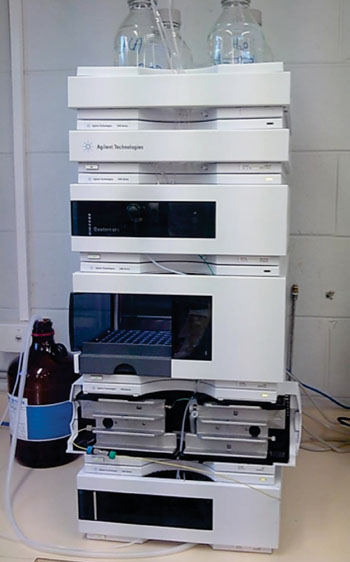Novel Method Identifies Fat Malabsorption
By LabMedica International staff writers
Posted on 11 Sep 2014
A novel clinical test known as the Serum Retinyl Palmitate Test (RP) has been assessed and validated for the diagnosis of fat malabsorption, and compared to the fecal fat test (FFT).Posted on 11 Sep 2014
The differential diagnosis for malabsorptive diarrhea is broad, encompassing luminal, mucosal and lymphatic disorders involving different organ systems and the possibility of undiagnosed systemic endocrine or immunodeficient diseases also highlights the importance of a thorough work-up.

Image: The Series 1200 high pressure liquid chromatography (HPLC) system (Photo courtesy of Agilent Technologies).
Clinical biochemists at the University of Calgary (AB, Canada) carried out a case-control study on patients identified with chronic diarrhea, defined as persistent symptoms for greater than four weeks, and suspected malabsorption. Healthy control subjects were also recruited. Blood samples were collected at intervals after the administration of oil-soluble vitamin A. A fecal fat test was conducted on samples of patients after the consumption of 100 grams of a fat diet. Patients were defined as malabsorbers if the 72-hour stool fat excretion was greater than 5.9 g/day.
Serum levels of retinol (vitamin A) and RP were measured by reversed-phase high pressure liquid chromatography (HPLC; Waters; Milford, MA, USA). The detection limit for retinol was 0.18 mg/L and for retinyl-palmitate, it was 0.02 mg/L. Sixteen patients completed this study, 8 cases and 8 control subjects. Fecal fat results were available for 15/16 patients. The sensitivity of the FFT was 100%, but the FFT specificity was 42%, as 4/7 control patients were identified as malabsorbers. Cases with short bowel syndrome (SBS) had the lowest RP levels, but this did not meet statistical significance. There was no significant difference for serum RP levels when comparing cases and control patients.
The authors concluded that the RP test did identify patients with severe malabsorption secondary to SBS, but the performance of the RP test in patients with malabsorption from non-SBS etiologies was poor. However, the so-called gold standard, 72-hour FFT, had poor performance characteristics, highlighting the need for more useful diagnostics in identifying malabsorption. The study was published on August 8, 2014, in the journal Clinica Chimica Acta.
Related Links:
University of Calgary
Waters













